Number of approved building permit increases by 5.4 percent during the first quarter of 2022
The number of approved building permits in NCR increased by 5.4 percent to 2,437 during the first quarter of 2021 from 2,312 of the same quarter of the previous year. Out of this total, by type of construction, residential buildings reported the highest with 1,501 or 61.6 percent while the non-residential ranked second with 292 or 12.0 percent of the total approved building permit applications. Annual rates for residential and non-residential type of building constructions were 3.6 and -5.8, respectively.
Meanwhile, combined approved building permits for additions, alterations and repairs went up by 16.5 percent to 644 building permits during the first quarter of 2022 from 533 of the same quarter of the previous year. (Figure 1 and Table 1)
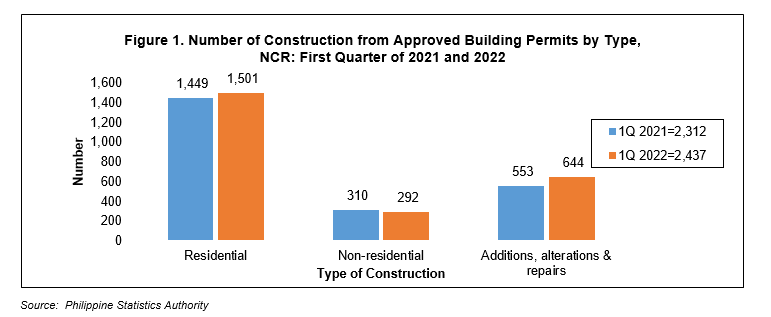
Relative to the entire country, NCR contributed 6.5 percent to the number of approved building permits and 17.0 percent to the total value of construction during the first quarter of 2022.
Value of constructions for residential type goes down by 58.6 percent
The total value of construction decreased by 54.0 percent to PhP 14.8 billion during the first quarter of 2022 from PhP 32.2 billion of the same quarter of 2021. Moreover, the aggregate value of residential construction in NCR decreased by 58.6 percent to PhP 7.9 billion in the first quarter of 2022 from PhP 19.2 billion during the same quarter of the previous year, while the value of construction for non-residential type of building went down by 55.2 percent to PhP 4.6 billion in first quarter of 2022 from PhP 10.3 billion in the same quarter of 2021. The total value for additions and alterations/repairs decreased by 16.7 percent to PhP 2.2 billion in the first quarter of 2022 from PhP 2.7 billion during the first quarter of 2021. (Figure 2 and Table 1)
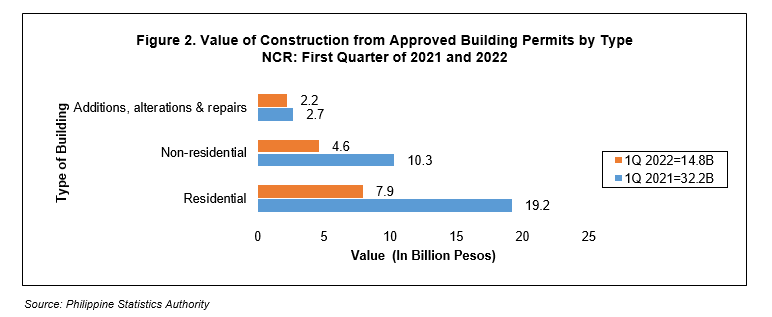
Single-type residential building records the highest number of approved building permits while residential condominium registers the highest value of construction
Among the types of residential building, single–type residential building registered the highest number of approved building permits with 1,138 applications or 75.8 percent of the total number of residential building construction. On the other hand, residential condominium recorded the highest value of construction amounting to PhP 3.4 billion or 42.3 percent of the total value of residential building construction. (Figure 3 and Table 1)
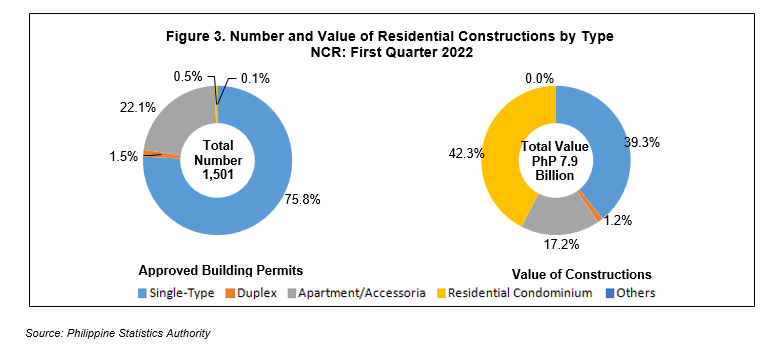
Commercial type of building ranks the highest among non-residential construction
Among the types of non-residential constructions, the commercial type recorded the highest number of 180 applications, comprising 61.6 percent of the total number and an aggregate value of PhP 1.3 billion or 28.5 percent of the total value of non-residential building construction. (Figure 4a, Figure 4b and Table 1)
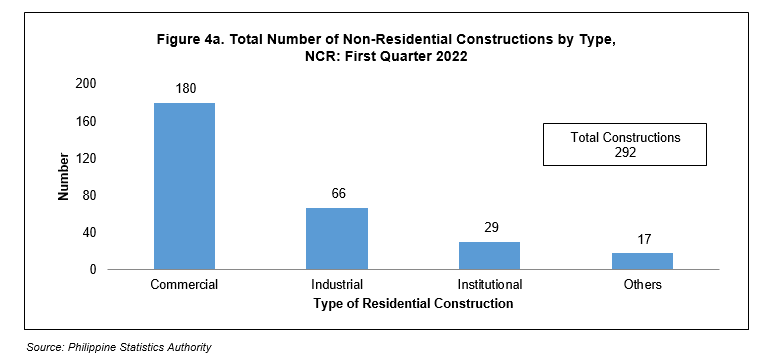

Number of constructions was highest in City of Valenzuela
City of Valenzuela continued to register the highest number of constructions with 504 constructions or 20.7 percent share to the total during the quarter. Completing the top three cities with the highest number of constructions were City of Paranaque with 267 (11.0%), and City of Caloocan with 231 (9.5%). (Figure 5a and Table 2)
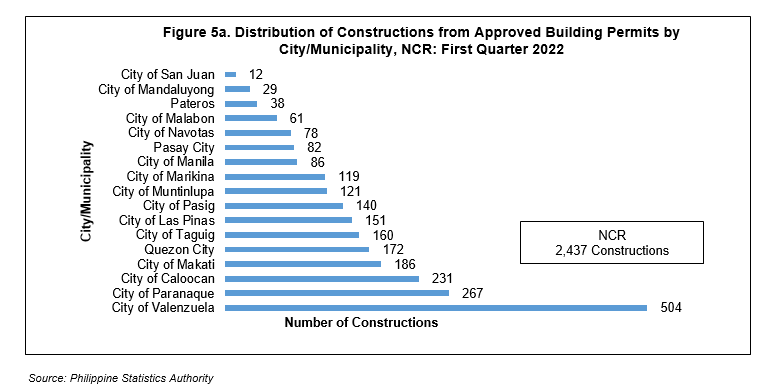
Top three cities contributed nearly half of the total value of constructions
The combined shares of the top three cities, in terms of value of constructions, amounted to PhP 71.93 billion or 48.6 percent of the total. These cities were:
- City of Taguig, PhP 2.8 billion (19.1%);
- Quezon City, PhP 2.6 billion (17.5%); and
- City of Parañaque, PhP 1.8 (12.0%) (Figure 5b and Table 2)
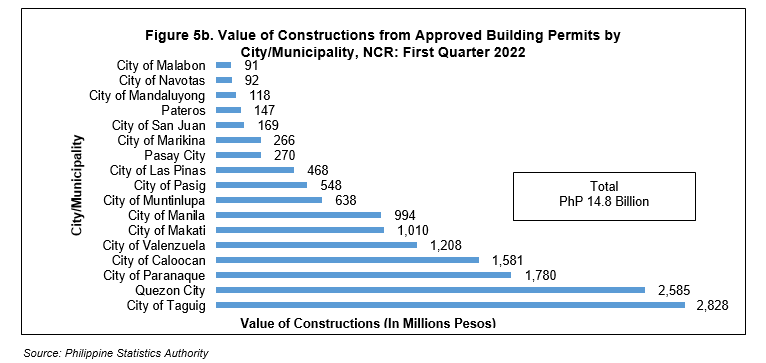
SGD.
PACIANO B. DIZON
Regional DIrector
Explanatory Notes
Scope and Coverage:
Private construction statistics from approved building permits relate to new constructions and additions, alterations and repairs of existing residential and non-residential buildings and other structures undertaken in all regions/provinces of the country.
Source of information:
Data are from the original applications of approved building permits collected by PSA field personnel from Local Building Officials in the five districts of NCR.
Limitations:
Data on building constructions refer to those approved applications during the reference period and not to construction work completed during the reference period.
The completeness of the number of building permits collected relies on the approval of applications filed with the LBOs. Hence, private building constructions without approved building permits are excluded in the tabulation of data.
Definition of Terms:
Building Permit – A written authorization granted by the Local Building Official (LBO) to an applicant allowing him to proceed with the construction of a specific project after plans, specification and other pertinent documents have been found to be in conformity with the National Building Code (PD 1096).
Building – Any independent, freestanding structure comprised of one or more rooms or other spaces, covered by a roof and enclosed with external walls or dividing walls, which extend from the foundation to the roof.
Construction – All on-site work done from site preparation, excavation, foundation, assembly of all the components and installation of utilities and equipment of building/structures.
Residential Building – A building for which its major parts or more than half of its gross floor area built for dwelling purposes. This type of building can be of the single house, duplex, an apartment and/or accessoria and residential condominium.
Single House – A complete structure intended for a single family or household, i.e. bungalow, 2-storey house, nipa hut.
Duplex – A structure, usually of two households, with complete living facilities for each; it is a single structure divided into two dwelling units by a wall extending from the floor to the ceiling.
Apartment – A structure, usually of two storeys, made up of independent living quarters, with independent entrances from internal walls and counts.
Accessoria – is a one or two-floor structure divided into several dwelling units, each dwelling unit having its own separate entrance from the outside.
Residential Condominium – A structure, usually of several storeys, consisting of multiple dwelling units.
Other residential constructions – Consist of school or company staff houses, living quarters for drivers and maids, and guardhouses.
Non-Residential Building – This type includes commercial, industrial, agricultural and institutional buildings.
Commercial Buildings – Office buildings and all buildings that are intended for use primarily in wholesale, retail and service trades; i.e. stores, hotels, restaurants, banks, etc.
Industrial Buildings – buildings which are used to house the production, assembly and warehousing activities of industrial establishments; i.e. factories, plants, mills, repair shops, machine shops, printing press, storage plant, electric generating plants
Institutional Buildings – buildings that are primarily engaged in providing educational instructions and hospital/health care, ports, airports and other government buildings; i.e. school, museums, libraries, sanitaria, churches, hospitals.
Agricultural Buildings – building, which are used to house live stocks, plants and agricultural products such as barn, poultry house, piggeries, stables, greenhouses and grain mill.
Other Non-Buildings Constructions – These include cemetery structures, street furniture, waiting sheds, communications towers, etc.
Addition – Any new construction that increases the height or area of an existing building/structure.
Alteration – Construction in a building/structure involving structure involving changes in the materials used, partitioning, location/size of openings, structural parts, existing utilities and equipment but does not increase the overall area thereof.
Repair – A remedial work done on any damaged or deteriorated portion/s of a building/structure to restore its original condition.
Floor Area of Building – The sum of the area of each floor of the building measured to the outer surface of the outer walls including the area of lobbies, cellars, elevator shafts and all communal spaces in multi-dwellings. Areas of balconies are excluded.
Total Value of Construction – The sum of the cost of building, electrical, mechanical, plumbing, and others. The value is derived from the approved building permit and represents the estimated value of the building or structure or structure when completed.
The components of the different NCR districts are as follows:
NCR I - City of Manila, City of Mandaluyong, City of San Juan
NCR II – Quezon City, City of Marikina
NCR III – City of Pasig, City of Makati, Taguig City, Pateros
NCR IV – Caloocan City, City of Malabon, City of Navotas, City of Valenzuela
NCR V – City of Las Piñas, City of Muntinlupa, City of Parañaque, Pasay City
